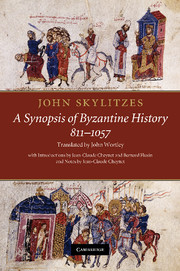Book contents
- Frontmatter
- Contents
- The English translator’s Preface
- Introduction
- Re-writing history: John Skylitzes’ Synopsis historion
- Foreword
- Chapter 1 Michael I Rangabe, the Kouropalates [811–813]
- Chapter 2 Leo V the Armenian [813–820]
- Chapter 3 Michael II the Stammerer [820–829]
- Chapter 4 Theophilos [829–842]
- Chapter 5 Michael III, the son of Theophilos [842–867], and his mother Theodora [842–862]
- Chapter 6 Basil I Kephalas, the Macedonian [867–886]
- Chapter 7 Leo VI the Philosopher (the Wise) [886–912]
- Chapter 8 Alexander [912–913]
- Chapter 9 Constantine VII, Porphyrogennetos [913–959]
- Chapter 10 Romanos I Lekapenos [919–944]
- Chapter 11 Constantine VII [944–959]
- Chapter 12 Romanos II the Younger [959–963]
- Chapter 13 Basil II Bulgaroktonos and Constantine VIII [976–1025]
- Chapter 14 Nikephoros II Phokas [963–969]
- Chapter 15 John I Tzimiskes [969–976]
- Chapter 16 Basil II and Constantine VIII bis [976–1025]
- Chapter 17 Constantine VIII [1025–1028]
- Chapter 18 Romanos III Argyros [1028–1034]
- Chapter 19 Michael IV the Paphlagonian [1034–1041]
- Chapter 20 Michael V Kalaphates [1041–1042]
- Chapter 21 Constantine IX Monomachos [1042–1055]
- Chapter 22 Theodora [1055–1056]
- Chapter 23 Michael VI the Elder/Stratiotikos [1056–1057]
- Glossary
- Bibliography
- Index
- References
Chapter 3 - Michael II the Stammerer [820–829]
Published online by Cambridge University Press: 05 July 2014
- Frontmatter
- Contents
- The English translator’s Preface
- Introduction
- Re-writing history: John Skylitzes’ Synopsis historion
- Foreword
- Chapter 1 Michael I Rangabe, the Kouropalates [811–813]
- Chapter 2 Leo V the Armenian [813–820]
- Chapter 3 Michael II the Stammerer [820–829]
- Chapter 4 Theophilos [829–842]
- Chapter 5 Michael III, the son of Theophilos [842–867], and his mother Theodora [842–862]
- Chapter 6 Basil I Kephalas, the Macedonian [867–886]
- Chapter 7 Leo VI the Philosopher (the Wise) [886–912]
- Chapter 8 Alexander [912–913]
- Chapter 9 Constantine VII, Porphyrogennetos [913–959]
- Chapter 10 Romanos I Lekapenos [919–944]
- Chapter 11 Constantine VII [944–959]
- Chapter 12 Romanos II the Younger [959–963]
- Chapter 13 Basil II Bulgaroktonos and Constantine VIII [976–1025]
- Chapter 14 Nikephoros II Phokas [963–969]
- Chapter 15 John I Tzimiskes [969–976]
- Chapter 16 Basil II and Constantine VIII bis [976–1025]
- Chapter 17 Constantine VIII [1025–1028]
- Chapter 18 Romanos III Argyros [1028–1034]
- Chapter 19 Michael IV the Paphlagonian [1034–1041]
- Chapter 20 Michael V Kalaphates [1041–1042]
- Chapter 21 Constantine IX Monomachos [1042–1055]
- Chapter 22 Theodora [1055–1056]
- Chapter 23 Michael VI the Elder/Stratiotikos [1056–1057]
- Glossary
- Bibliography
- Index
- References
Summary
After Leo was put to death, his assassins callously dragged his corpse through the Skyla gate and brought it into the Hippodrome, fearing nothing because the imperial palace was guarded at all points by their own forces. His wife was hauled off from the palace together with her four children, Symbatios (whose name was changed to Constantine after his proclamation as co-emperor), Basil, Gregory and Theodosios. They were thrust into a skiff and brought to the island of Prote where all four were castrated. Theodosios succumbed and went to share his own father’s grave.
As for Michael, he was now released from the prison of the papias, his feet still restrained by fetters because the key to the irons was kept in Leo’s bosom. It was thus that he now sat on the imperial throne, fetters and all; that is how he was when all those then holding palatine appointments acclaimed him and fell down before him. Then, towards midday, when the rumour had spread in all directions (by now his fetters had been struck off with a hammer), without even washing his hands, with no fear of God in his heart nor with any thought of what else ought to be done, off he went to the Great Church of the [holy] Wisdom, anxious to be crowned by the hand of the patriarch and to be publicly acclaimed. He trusted nobody other than his fellow conspirators who had carried out the assassination. At this point one might well wonder at these two emperors’ lack of judgement: the outgoing one who had no one to help him among such a large and varied rout of flatterers, all of whom took refuge in their holes like snakes; and the disorderly, shameless nature of the one after him who went into church, not like some murderer or executioner with bloodied hands, but rather as a victorious athlete and conqueror, [25] exulting over what had happened – he who had just shed the blood of a fellow countryman, not in any common place, but in God’s sanctuary where the Lord’s blood is daily poured out for the forgiveness of our sins.
- Type
- Chapter
- Information
- John Skylitzes: A Synopsis of Byzantine History, 811–1057Translation and Notes, pp. 27 - 50Publisher: Cambridge University PressPrint publication year: 2010

